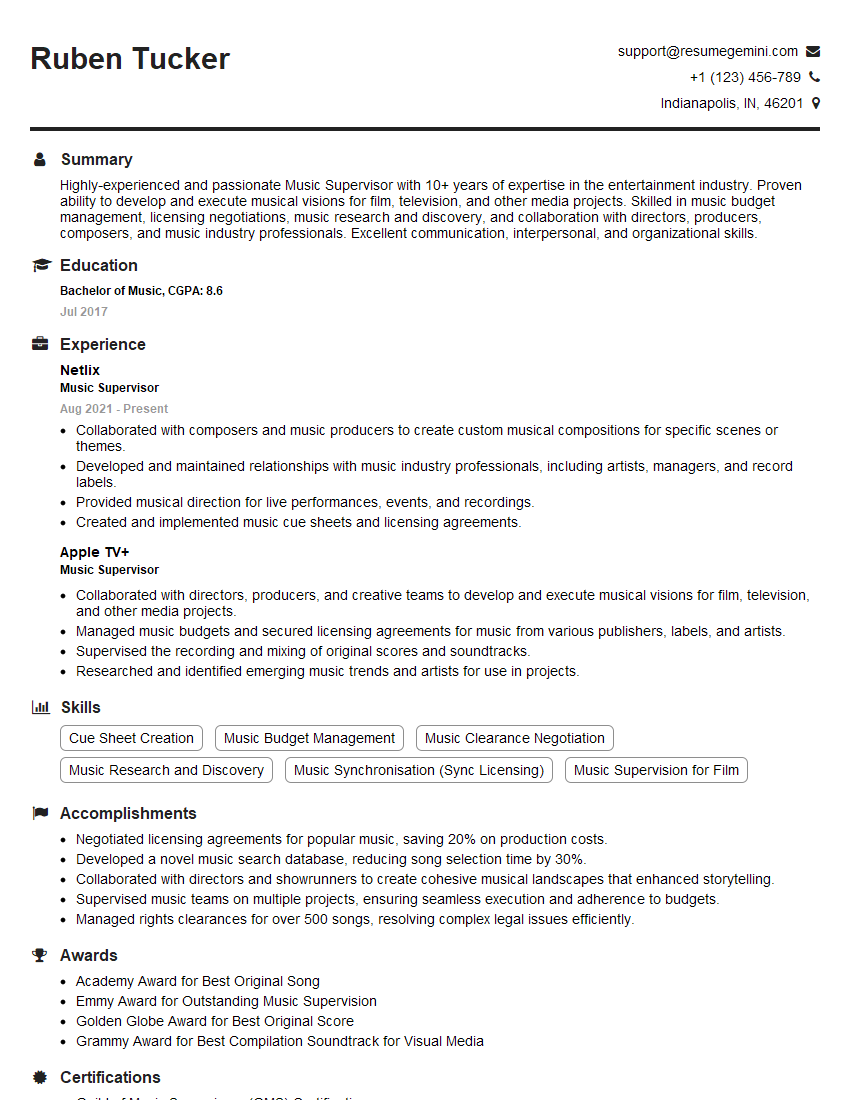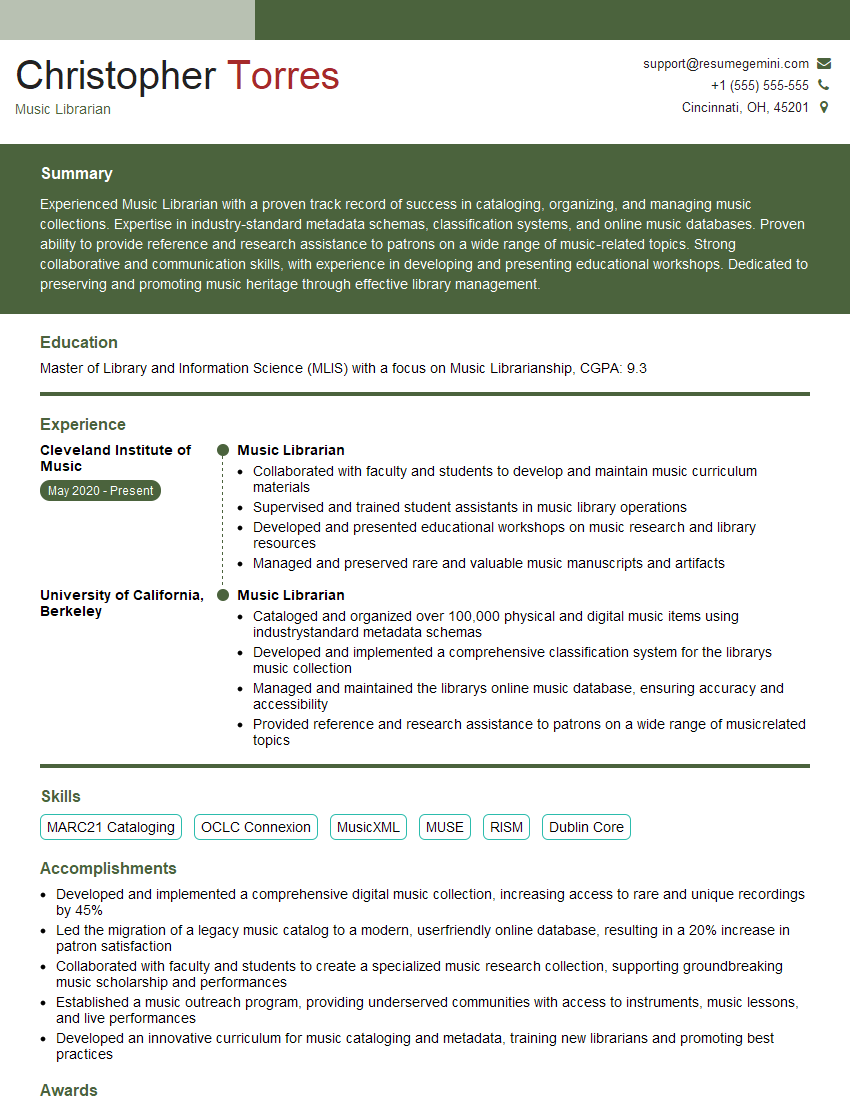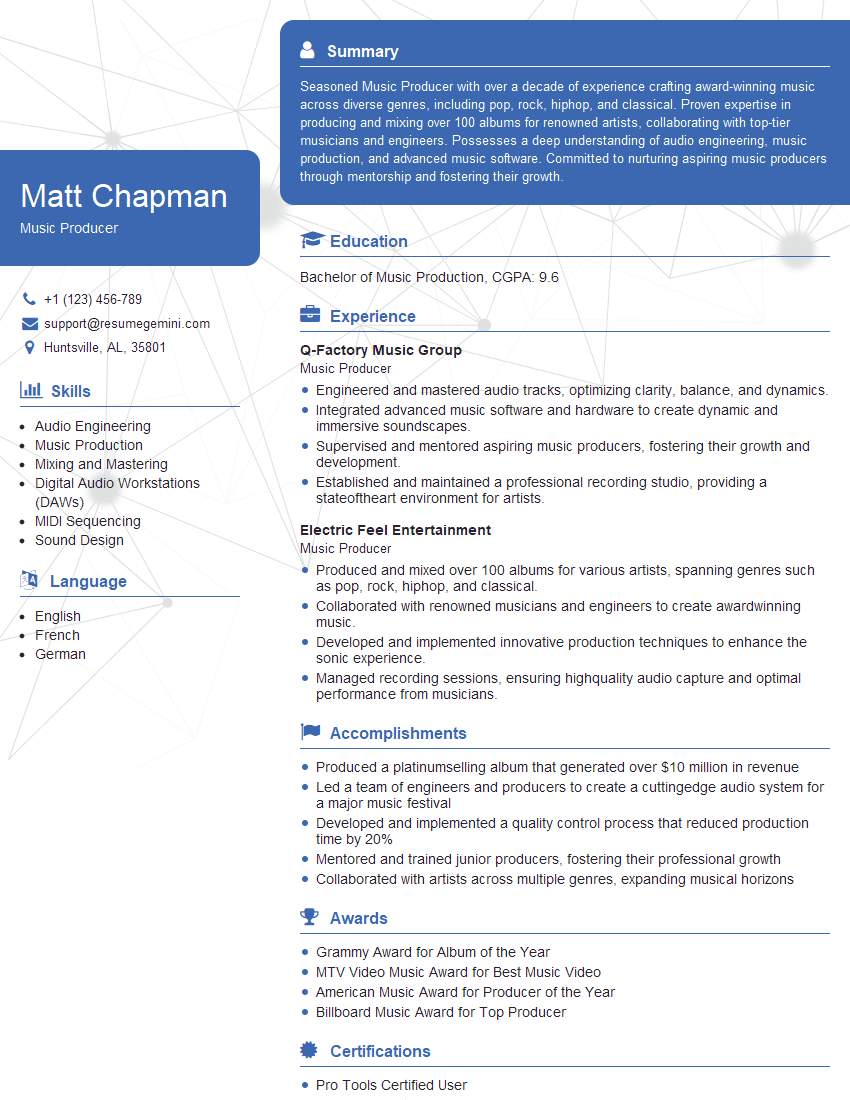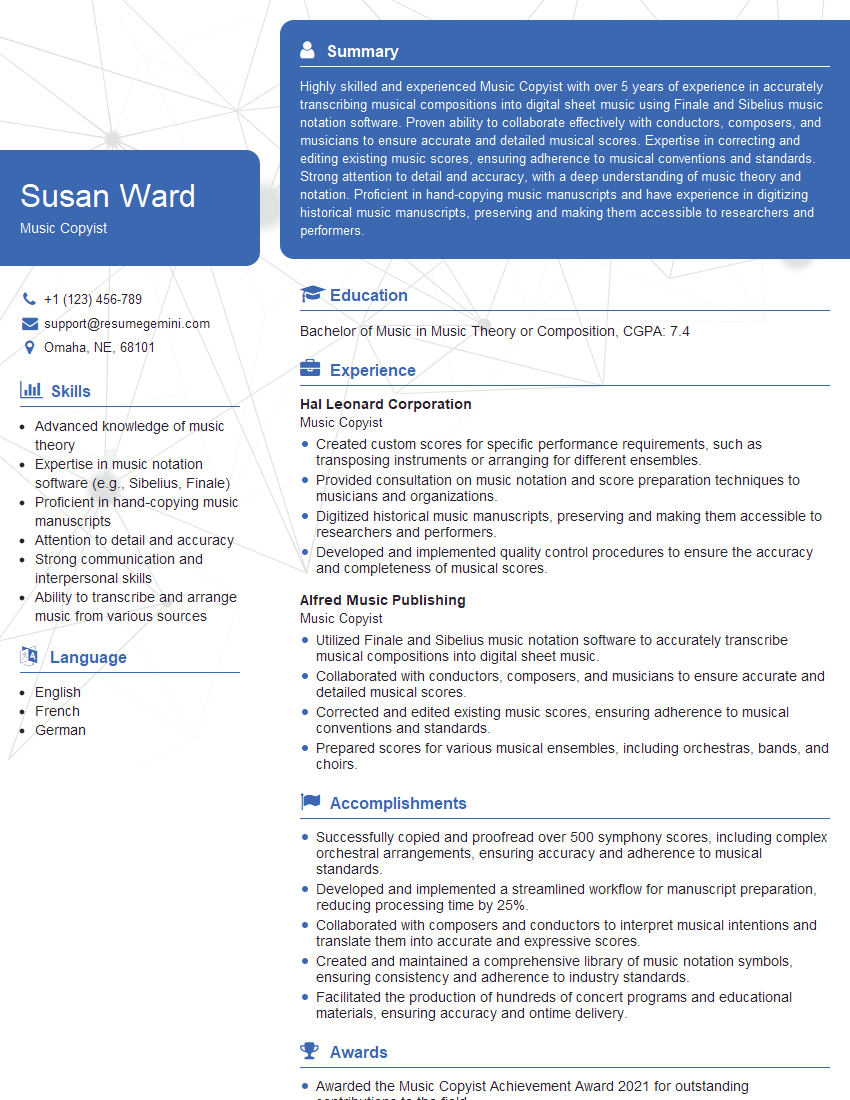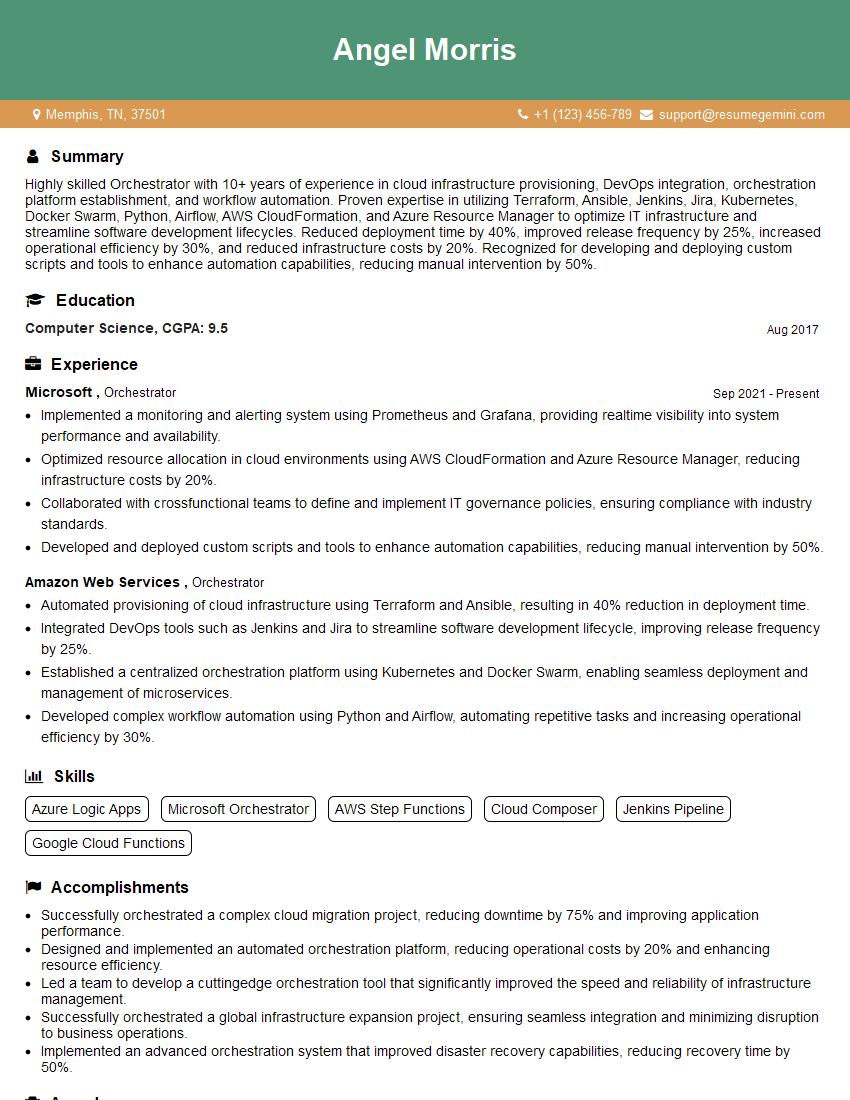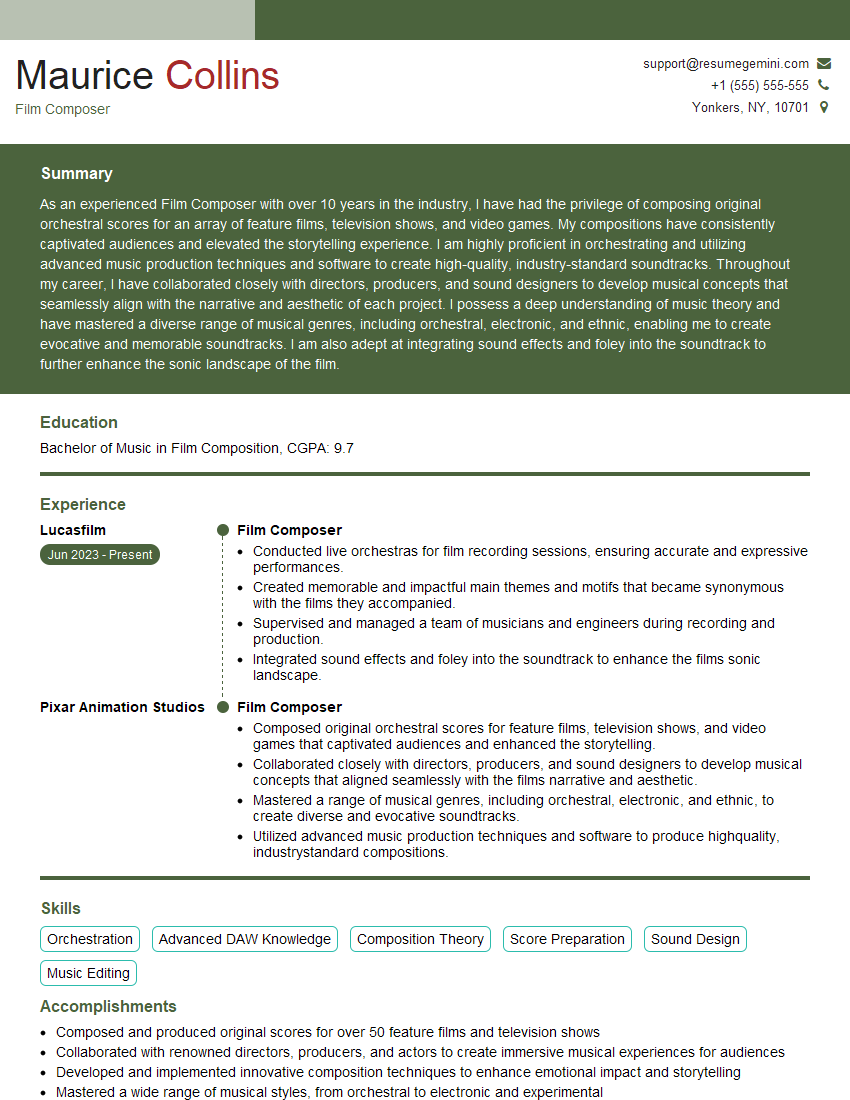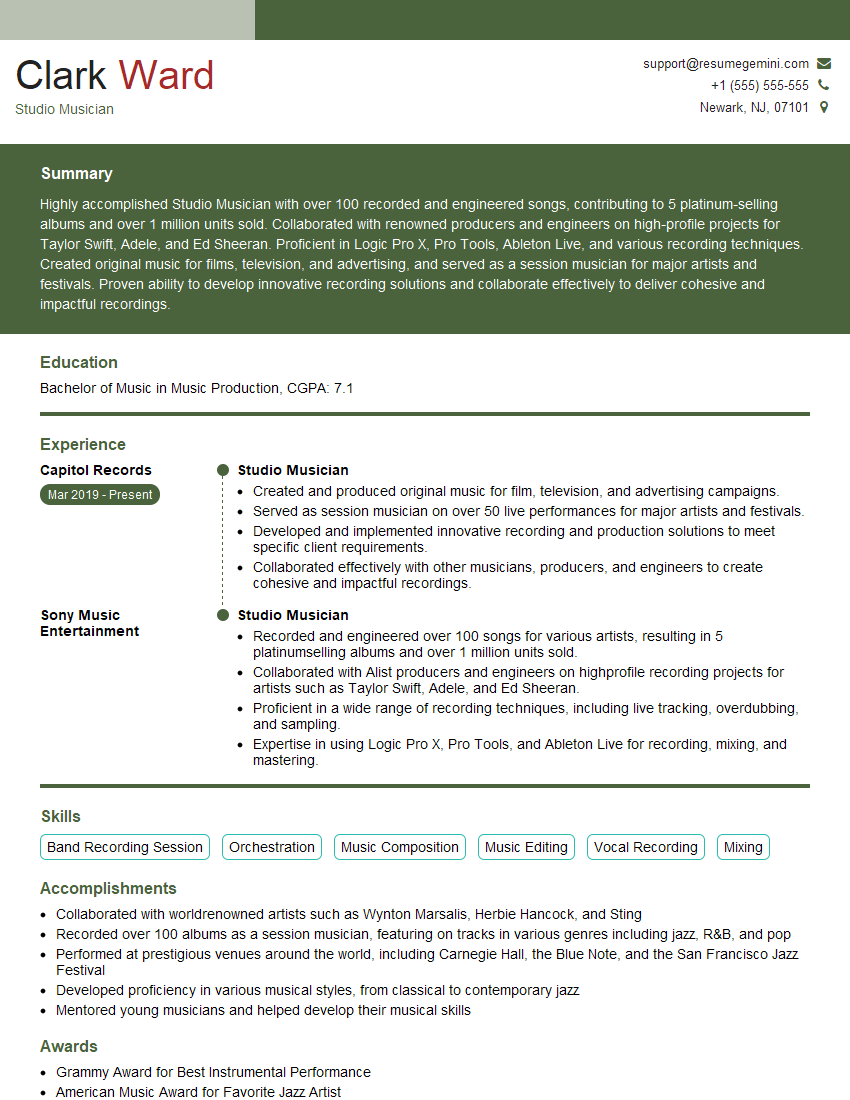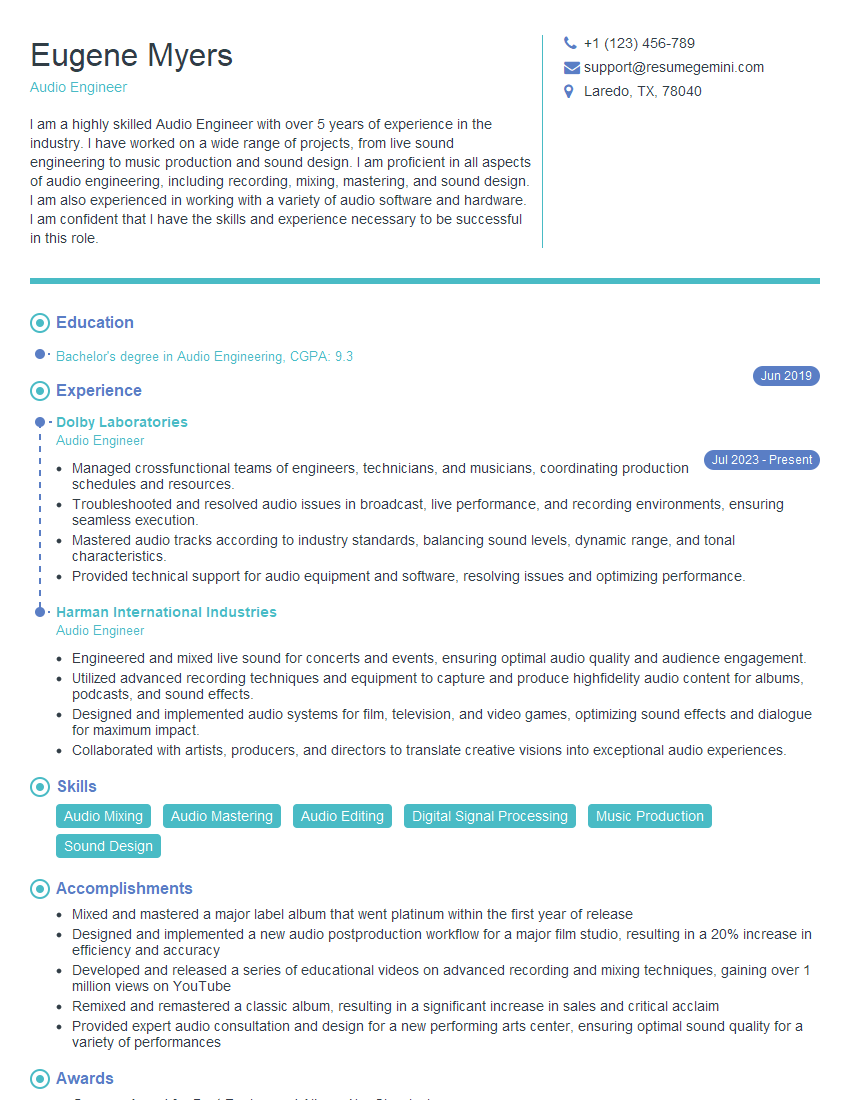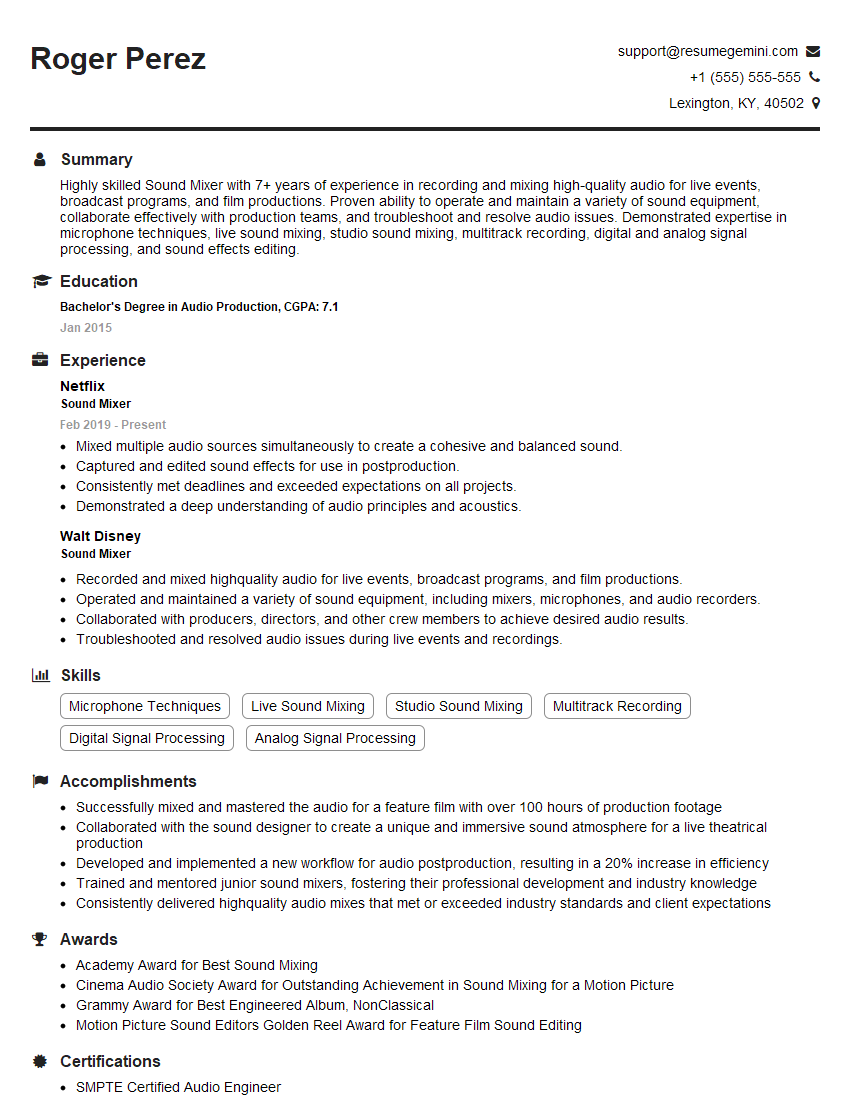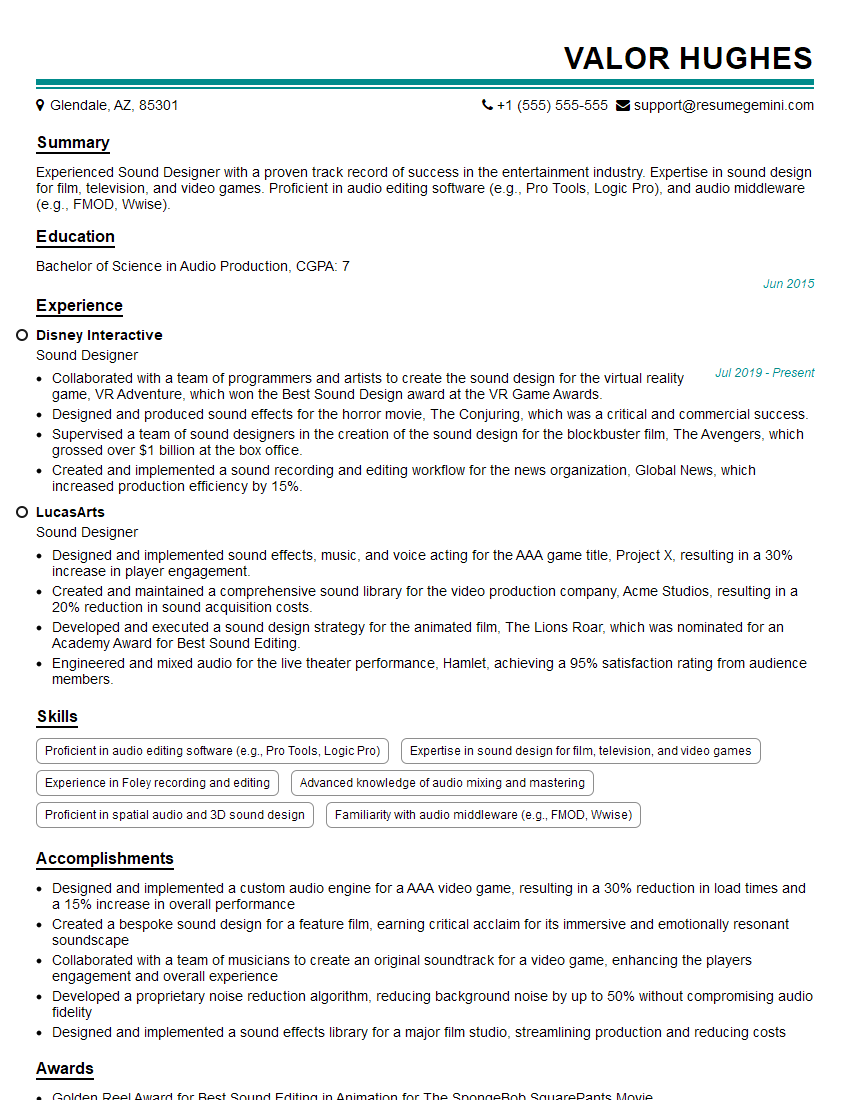The right preparation can turn an interview into an opportunity to showcase your expertise. This guide to Experience in Film, Television, or Game Music Composition interview questions is your ultimate resource, providing key insights and tips to help you ace your responses and stand out as a top candidate.
Questions Asked in Experience in Film, Television, or Game Music Composition Interview
Q 1. Describe your experience with various music notation software (Sibelius, Finale, Dorico).
I’m proficient in several music notation software packages, each with its strengths. Sibelius, for example, excels in its intuitive interface and powerful playback engine, making it ideal for quick sketching and initial composition. I often use it for initial ideas and sketching out melodic and harmonic ideas. Finale, on the other hand, boasts a vast library of templates and highly customizable features, proving invaluable for complex orchestral scores where precise control over every note is critical. I’ve utilized Finale extensively in projects requiring intricate scoring, particularly for film scores with large ensembles. More recently, I’ve been exploring Dorico, which is rapidly becoming my preferred choice. Its streamlined workflow, excellent engraving capabilities, and advanced features like its powerful playback and notation flexibility are truly impressive. It significantly streamlines my workflow and allows me to focus on the creative aspects of composition. The choice of software often depends on the specific project’s demands and my personal preference for a given task.
Q 2. Explain your process for creating a musical score for a specific scene or level.
My process for creating a musical score for a scene or level is iterative and highly collaborative. It begins with a deep understanding of the visuals and narrative. I’ll carefully review the script, storyboard, animatic (if applicable), or gameplay footage, identifying key emotional moments and narrative beats. I then translate these moments into musical concepts, considering tempo, instrumentation, harmony, and dynamics. For example, a tense chase scene might require a fast tempo, dissonant harmonies, and a prominent percussion section, whereas a romantic scene might use a slower tempo, consonant harmonies, and strings. I begin by sketching out musical ideas – often using a combination of digital audio workstations (DAWs) and notation software. Once I have a strong thematic foundation, I refine the score, incorporating feedback from the director, producers, or game designers. This process often involves multiple revisions and iterations until the music perfectly complements the visuals and story.
Q 3. How do you adapt your musical style to different genres (e.g., action, drama, comedy)?
Adapting my musical style to different genres is crucial. For action scenes, I employ driving rhythms, powerful brass, and impactful percussion to create a sense of urgency and excitement. Think of the iconic brass fanfare in many action movie scores. For drama, I might opt for more melancholic melodies, slower tempos, and richer harmonies, using strings and woodwinds to evoke emotion. A comedic scene, on the other hand, might benefit from quirky melodies, unexpected rhythmic shifts, and perhaps even the inclusion of unconventional instruments to add a playful touch. I find that understanding the emotional core of each genre is key. I actively research scores from similar genres for inspiration, but I always strive to incorporate my personal style to maintain originality.
Q 4. Discuss your experience working with orchestras or other musical ensembles.
I have extensive experience collaborating with various musical ensembles, from small chamber groups to full orchestras. This experience has taught me the importance of clear communication and understanding the capabilities and limitations of each instrument. Working with an orchestra involves meticulous preparation. I provide the orchestra with detailed scores and parts, ensuring clarity and accuracy. During rehearsals, effective communication with the conductor is critical to ensure the music is interpreted as intended. I’ve found that building rapport with musicians fosters a collaborative environment, resulting in a richer and more nuanced performance. For example, I once worked with a string quartet to create an intimate score for an independent film; the close collaboration allowed for spontaneous interpretations and a truly organic result.
Q 5. How do you handle feedback and revisions during the music composition process?
Feedback and revisions are integral to the creative process. I actively solicit feedback from directors, producers, and other stakeholders throughout the process. I see feedback not as criticism, but as an opportunity for improvement. My approach is collaborative; I always aim to understand the reasons behind the suggestions. I might use a version control system to track revisions. I treat each revision as a chance to refine the score, ensuring it aligns perfectly with the overall vision. Sometimes, adjustments may involve subtle changes in instrumentation, tempo, or dynamics; other times, they may require more substantial revisions of the melodic or harmonic structure. The key is to remain open to constructive criticism and use it to elevate the final product.
Q 6. Describe your workflow for integrating music with sound effects and dialogue.
Integrating music with sound effects and dialogue requires careful planning and execution. I typically work closely with sound designers and editors. We might use a digital audio workstation (DAW) to manage all audio elements. Timing is paramount; the music needs to be precisely synchronized with the visuals and dialogue to avoid clashes or unwanted sonic interference. I often create several versions of the score – a full orchestral version, a more minimal version suitable for scenes with prominent dialogue, and perhaps even underscore versions for certain sections. This flexibility allows for seamless integration and dynamic mixing. Careful consideration of the frequency ranges of music and sound effects is crucial to prevent masking or muddiness in the final mix.
Q 7. What are your preferred methods for creating musical themes and motifs?
My methods for creating musical themes and motifs are varied, often drawing inspiration from both traditional composition techniques and experimental approaches. I might start with a simple melodic idea, developing it through variations and transformations. Or I might begin with a harmonic progression, building melodic lines around it. I often experiment with different instruments and timbres to find the right sound for a particular motif. Sometimes, I’ll use generative techniques or algorithms to explore unexpected melodic or harmonic ideas. Regardless of my starting point, the process involves refinement and iteration until the theme or motif feels both evocative and suitable for its intended function. For example, a main theme might undergo many iterations before it feels emotionally resonant and memorable, capturing the essence of the film, game, or television show.
Q 8. How familiar are you with different musical instruments and their capabilities?
My familiarity with musical instruments spans a wide range, encompassing both acoustic and electronic instruments. I’m proficient in playing the piano and guitar, which are fundamental to my compositional process. My understanding extends beyond mere performance; I possess a deep knowledge of their timbral characteristics, expressive capabilities, and how they interact within an ensemble. For example, I understand how the resonance of a cello differs from a violin and how that can be leveraged to create specific emotional responses in the listener. I also have working knowledge of orchestral instruments, woodwinds, brass, percussion—their ranges, technical limitations, and unique sounds. This is crucial for writing effective scores that consider the practical aspects of instrumentation. Finally, my experience extends to synthesizers and digital audio workstations (DAWs), enabling me to create and manipulate a vast array of sounds beyond traditional acoustic instruments.
- Acoustic Instruments: Piano, Guitar, Violin, Cello, Flute, Clarinet, Trumpet, Trombone, Percussion (various)
- Electronic Instruments/Software: Synthesizers (various), Samplers, Drum Machines, DAW plugins (e.g., virtual instruments)
Q 9. How do you manage time constraints and deadlines in a fast-paced production environment?
Managing time constraints in a fast-paced production environment requires meticulous planning and efficient workflow. My approach involves several key strategies. First, I meticulously review the project timeline and break down the composition process into manageable tasks with clearly defined deadlines. I utilize project management tools to track progress and identify potential bottlenecks early on. Second, I prioritize tasks based on their urgency and impact, focusing on the most crucial elements of the score first. Third, I employ efficient compositional techniques, such as templating and modular scoring, to expedite the process without compromising quality. Finally, open communication with the director and producer is essential; I proactively update them on progress and discuss any potential challenges that may impact the timeline. For example, on a recent television show, we faced a compressed deadline for a crucial action sequence. By using pre-composed musical motifs and quickly adapting them to the visual elements, I was able to deliver the score on time without sacrificing the emotional intensity.
Q 10. Explain your process for creating a musical score that enhances the emotional impact of a scene.
Creating a musical score that enhances the emotional impact of a scene is a multi-stage process that begins with careful analysis of the visual narrative. I first watch the scene multiple times, noting key emotional moments, character arcs, and pacing. I then create a detailed outline of the musical events, identifying sections where the music needs to build tension, provide resolution, or underscore specific emotions. This outline guides the composition process, ensuring the music aligns perfectly with the visuals. Next, I experiment with different musical styles, harmonies, and instrumentation to find the most effective approach for conveying the desired emotions. I consider the scene’s setting, characters, and overall tone when making these choices. Finally, I refine the score through multiple iterations, incorporating feedback from the director and other team members. For example, in a recent project, a scene required a shift from tense anticipation to sudden, overwhelming grief. I used a dissonant, rising string section to build the tension, followed by a stark, minimalist piano melody to reflect the character’s despair, achieving the desired emotional impact.
Q 11. Describe your experience with music licensing and copyright issues.
My experience with music licensing and copyright is extensive, stemming from years of working in the industry. I understand the importance of securing the necessary rights to use any pre-existing musical material in a composition. This includes obtaining licenses for samples, background music, and any other copyrighted work. I am adept at navigating the complexities of copyright law, ensuring all musical elements used are legally cleared. I understand different licensing agreements (e.g., mechanical, synchronization, master use), and I work closely with music supervisors and legal teams to ensure compliance. In cases where custom music is needed, I meticulously document the creation process to safeguard my ownership rights. Failing to properly address licensing can lead to significant legal issues and financial penalties. I consider it a crucial part of responsible professional practice.
Q 12. How do you collaborate effectively with directors, producers, and other team members?
Effective collaboration is paramount in film, television, and game music composition. I believe in open communication, active listening, and a collaborative spirit. I prioritize building strong relationships with directors, producers, and other team members by clearly understanding their vision and contributing my expertise to achieve their goals. Regular meetings and feedback sessions are essential for ensuring the music aligns with the project’s overall vision. I actively solicit feedback and am receptive to suggestions, using them to refine my work and enhance the final product. Constructive criticism is welcomed; I view it as an opportunity for improvement. For instance, on a recent project, the director wanted to convey a specific feeling of unease during a particular scene. Through a series of discussions, we decided on using a specific instrumentation and harmonic approach, resulting in a more powerful and impactful scene.
Q 13. What software do you utilize for audio editing and mixing?
My primary software for audio editing and mixing is Logic Pro X, although I also have extensive experience with Pro Tools and Ableton Live. Logic Pro X offers a powerful and comprehensive suite of tools for composition, recording, editing, mixing, and mastering. I find its workflow efficient and intuitive, allowing me to focus on the creative aspects of music production. The advanced features, including its extensive library of virtual instruments and effects, are invaluable in achieving a high-quality final product. My proficiency in these DAWs enables me to work effectively in various production environments and adapt to different workflows as needed.
Q 14. How do you incorporate sound design elements into your musical compositions?
Incorporating sound design into my musical compositions is a vital aspect of creating immersive and emotionally impactful scores. I view sound design not just as a separate element, but as an integral part of the musical fabric. I use sound design to enhance the emotional weight of the music, add layers of texture, and create a more realistic soundscape. This can involve manipulating existing sounds (e.g., using granular synthesis to create ethereal textures from simple recordings) or creating completely new sounds from scratch. For instance, in a recent project, I created the sound of a ghostly wind by layering processed recordings of wind chimes and using subtle distortion and reverb to enhance the otherworldly feel. Careful consideration of spatial audio and other sound design techniques adds depth and realism, helping to transport the listener into the world of the visual narrative.
Q 15. Explain your understanding of different audio formats and their applications.
Understanding audio formats is crucial for a composer. Different formats offer varying levels of quality, file size, and compatibility. The choice depends on the project’s requirements and target platform.
- WAV (Waveform Audio File Format): A lossless format, meaning no data is lost during encoding. It’s ideal for studio work, mastering, and archiving, but files are large.
- AIFF (Audio Interchange File Format): Another lossless format, similar to WAV, primarily used on Apple platforms.
- MP3 (MPEG Audio Layer III): A lossy format, meaning some data is discarded for smaller file sizes. Widely used for online streaming and distribution due to its compact size, but quality can be compromised at very low bitrates.
- AAC (Advanced Audio Coding): A lossy format offering better quality than MP3 at comparable file sizes. Commonly used for digital distribution and streaming.
- FLAC (Free Lossless Audio Codec): A lossless format offering high-quality audio compression. A good alternative to WAV for archiving or distributing high-fidelity audio without the large file sizes.
- OGG Vorbis: A royalty-free, open-source lossy format often used in online streaming and open-source projects.
For example, I’d use WAV for the final master of a film score, MP3 for online distribution of a game’s soundtrack, and FLAC for archiving my project files.
Career Expert Tips:
- Ace those interviews! Prepare effectively by reviewing the Top 50 Most Common Interview Questions on ResumeGemini.
- Navigate your job search with confidence! Explore a wide range of Career Tips on ResumeGemini. Learn about common challenges and recommendations to overcome them.
- Craft the perfect resume! Master the Art of Resume Writing with ResumeGemini’s guide. Showcase your unique qualifications and achievements effectively.
- Don’t miss out on holiday savings! Build your dream resume with ResumeGemini’s ATS optimized templates.
Q 16. What strategies do you employ to ensure the quality and consistency of your audio work?
Maintaining quality and consistency is paramount. My strategies involve meticulous planning, a robust workflow, and rigorous quality control.
- Detailed Planning: I start with a detailed plan outlining the project’s scope, desired sound, and technical specifications.
- Version Control: Using a version control system (like Git) to track changes and revert to earlier versions if necessary ensures consistency.
- Template Creation: I create project templates with standardized settings for sample rates, bit depths, and other parameters for consistency across tracks.
- Regular Backups: Frequent backups prevent data loss and allow for easy recovery in case of a mishap.
- Quality Checkpoints: I incorporate regular listening sessions throughout the process, comparing work to established benchmarks and noting areas for improvement.
- Collaboration and Feedback: Seeking feedback from colleagues, sound designers, and the director enhances quality and addresses potential issues early.
For instance, during a recent project, I found a subtle inconsistency in the reverb settings across several cues. Thanks to my version control system, I was able to easily revert to an earlier, consistent version and correct the issue quickly.
Q 17. Describe your experience with creating interactive musical scores for video games.
Creating interactive music for video games is a fascinating challenge requiring a deep understanding of both music and game design. My approach involves utilizing tools and techniques to create dynamic and responsive scores.
- Dynamic Music System Design: I design systems that adjust the music based on in-game events, player actions, and environmental changes. This might involve using middleware like Wwise or FMOD.
- Music Cue Implementation: I create individual music cues that are triggered and blended based on predefined rules or triggers within the game engine.
- Interactive Elements: I incorporate interactive elements, such as musical stingers or environmental sounds that respond to player input, providing a more engaging experience.
- Adaptive Music Systems: For more complex games, implementing adaptive music systems that evolve and change over time based on the player’s progress is crucial for immersion and emotional impact.
In one project, I developed a system where the music intensity dynamically increased during combat sequences, creating a sense of urgency. After combat, the music gradually shifted back to a more ambient feel, reflecting the shift in gameplay.
Q 18. How do you balance creative freedom with the technical requirements of a project?
Balancing creative freedom with technical constraints is a constant juggling act. It involves open communication, compromise, and a willingness to adapt.
- Open Communication: Frequent discussions with the project lead and other team members ensure everyone understands the technical limitations and creative vision.
- Iterative Process: A flexible and iterative approach allows for experimentation while keeping the project on track.
- Compromise and Adaptation: Sometimes creative ideas need to be modified to meet technical requirements. I’m prepared to find creative solutions within the constraints.
- Prioritizing Objectives: Understanding the project’s key goals helps prioritize creative choices and technical requirements.
For example, while creating a soundtrack for a low-budget indie game, I had to adapt my orchestral ambitions to a smaller ensemble, focusing on the core themes and instrumentation to maximize impact within the limitations.
Q 19. What techniques do you use for creating believable and immersive soundscapes?
Creating believable and immersive soundscapes requires a multi-faceted approach, combining sound design, spatial audio, and careful attention to detail.
- Layered Sounds: I utilize multiple layers of sound, from subtle ambient textures to distinct sound effects, to create depth and realism.
- Spatial Audio: Employing panning, reverb, and other spatial audio techniques adds to the sense of environment and immersion.
- Sound Design Techniques: Using sound design techniques such as filtering, equalization, and effects processing, I tailor sounds to fit specific environments or moods.
- Environmental Sounds: Incorporating realistic environmental sounds such as wind, rain, or animal noises can bring a location to life.
- Reference Materials: Listening to real-world recordings or referencing existing soundscapes helps create a more grounded and realistic approach.
For instance, while creating a soundscape for a forest scene, I layered ambient sounds of birdsong, rustling leaves, and distant wind, creating a lush and believable atmosphere.
Q 20. Discuss your experience with different mixing techniques (e.g., stereo, surround sound).
My experience encompasses various mixing techniques, each with its own strengths and weaknesses. The choice depends on the project’s requirements and delivery platform.
- Stereo Mixing: A standard approach suitable for most applications, such as television, film, and many games. It offers a balance between fidelity and accessibility.
- Surround Sound Mixing (5.1, 7.1): Used for immersive experiences, enhancing spatial awareness and creating a more engaging auditory environment, often employed in cinema and high-end gaming. This allows for precise placement of sounds in a 3D space.
- Ambisonic Mixing: A more advanced technique that offers increased flexibility and allows for rendering to various speaker configurations (including headphones).
- Headphone Mixing: Requires careful consideration of stereo imaging and spatial cues to create a satisfying listening experience on headphones. This is often crucial for the gaming industry.
Recently, I worked on a project that required both stereo and 5.1 surround mixes. The 5.1 mix provided an immersive cinematic experience for home theater systems while the stereo mix ensured compatibility with standard playback devices.
Q 21. How do you use music to build tension, suspense, and release in a narrative?
Music is a powerful tool for manipulating emotions and building narrative tension. I utilize several techniques to effectively achieve this.
- Dynamic Range: Gradually increasing or decreasing the dynamic range (the difference between the loudest and quietest parts) can create anticipation and release. A quiet moment before a loud one intensifies the impact of the loud part.
- Tempo and Rhythm: Increasing tempo and using driving rhythms can build tension, while slowing tempo and using more legato phrasing can evoke suspense or create a sense of foreboding.
- Instrumentation and Harmony: Using dissonant harmonies and unsettling instrumentation can heighten tension, while consonant harmonies and soothing instruments can create a sense of release or calm.
- Motif Development: Developing a musical motif and subtly transforming it throughout a scene can create a sense of impending doom or unresolved conflict, effectively building suspense.
- Silence and Pause: Strategic use of silence or pauses can be even more effective than music in building tension, leaving the audience hanging, anticipating what will happen next.
For instance, in a chase scene, I’d use fast tempo and driving percussion to build tension, then briefly reduce the volume and tempo just before a major event to create a moment of suspense before unleashing a climax.
Q 22. Describe your experience with temp tracks and their role in the scoring process.
Temp tracks, or temporary music tracks, are crucial in the film scoring process. They’re essentially placeholder music—often pre-existing royalty-free tracks or even existing film scores—used during the editing process to help visualize the pacing, mood, and emotional arc of a film or show. They act as a guide, allowing editors and directors to refine the timing and emotional impact of scenes before the composer begins work on the original score.
My experience with temp tracks spans numerous projects. I often find myself analyzing the temp track choices made by the editor; understanding why a specific track was chosen for a scene gives me incredible insight into the director’s vision. For example, if a dramatic scene uses a heroic orchestral piece, it suggests a certain level of emotional weight and grandiosity that my original score needs to reflect, albeit in a unique and original way. I consider the temp track as a starting point for a conversation, not a rigid blueprint.
After reviewing the temp tracks, I’ll create my own score, sometimes drawing inspiration from the selected pieces but ensuring it ultimately embodies my creative vision and fits seamlessly with the film’s overall sound design.
Q 23. How do you approach scoring scenes with dialogue or complex visual effects?
Scoring scenes with dialogue or complex visual effects requires a delicate balance. The music needs to support the narrative without overpowering the dialogue or competing with the visual spectacle. For dialogue-heavy scenes, I often opt for subtle, atmospheric textures and underscoring—music that sits underneath the dialogue, adding emotional depth without distracting the audience.
With complex visual effects, the music’s role can vary dramatically depending on the desired effect. For example, in a thrilling action sequence, the music might be driving and percussive, mirroring the on-screen intensity. However, for a more emotionally driven sequence with intricate VFX, the music might be more melodic and evocative, amplifying the emotional impact of the visuals. I carefully consider the visual rhythm and pacing of the sequence, using musical motifs to highlight key moments or characters, all while maintaining a cohesive narrative through the score.
One project involved a scene with a transforming robot and intense hand-to-hand combat. The music needed to dynamically shift between powerful orchestral hits accompanying the robot’s transformations and more percussive elements to underscore the close-quarters combat. This required meticulous synchronization between the music and visual effects, ensuring a powerful and unified experience.
Q 24. What are your preferred methods for spotting music for a film or TV show?
Spotting music is the process of identifying where the music will go within a film or TV show. I prefer a collaborative approach, working closely with the director and editor during spotting sessions. We typically watch the film together, scene by scene, discussing the emotional tone, desired impact, and potential musical cues.
I use a combination of methods. I often start by marking potential cue points on a printed script and then annotating those cues with initial musical ideas and concepts. Then, in the spotting session, I will use software such as Logic Pro X’s Score Editor or Sibelius to create a rough representation of the timing and placement of musical cues. This is not about final notes; it’s about getting the tempo, mood, and general length of each cue correct. A simple click track often works to represent the rhythmic core of the piece.
This collaborative process allows for immediate feedback and adjustments. The director’s vision is paramount, and my role is to translate that vision into a compelling musical landscape.
Q 25. Discuss your experience with working with different types of budgets and timelines.
Working with varying budgets and timelines is a fundamental aspect of film and television scoring. On high-budget projects, I have access to larger orchestras, more sophisticated recording studios, and a longer production schedule, allowing for greater detail and refinement in the music. This enables more elaborate compositions and multiple revisions.
However, in lower-budget projects, resourcefulness and efficiency become key. This often involves utilizing smaller ensembles, virtual instruments, and streamlined workflows. I might use pre-recorded samples or MIDI to achieve certain sounds that could not otherwise be captured efficiently due to budget constraints. The creative challenge lies in achieving the same emotional impact despite these limitations. Time management is crucial, requiring precise planning and a strong understanding of workflow optimization.
Regardless of the budget, my goal remains consistent: to deliver the highest quality score possible given the available resources. This involves creative problem-solving and a collaborative approach to ensure the project’s success.
Q 26. How do you adapt your composition style to different target audiences?
Adapting my composition style to different target audiences involves careful consideration of several factors, including age, cultural background, and the overall tone of the project. A children’s animated film will naturally require a different musical approach than a dark thriller.
For younger audiences, I might utilize brighter instrumentation, simpler melodies, and faster tempos. For more mature audiences, I might explore more complex harmonies, darker textures, and slower, more deliberate pacing. In a project targeting a specific cultural group, I will research and incorporate musical styles or instruments that are culturally relevant to enhance audience engagement and emotional connection.
For example, I recently scored a historical drama set in Japan. I incorporated traditional Japanese instruments like the Koto and Shakuhachi into the score to add authenticity and cultural depth. This created a more immersive and resonant experience for the viewers.
Q 27. Describe your process for creating a compelling and memorable main theme.
Creating a memorable main theme is a crucial step in establishing the overall sonic identity of a film or TV show. My process usually starts with a deep understanding of the project’s narrative and themes. I try to capture the essence of the story in a single musical idea—a melodic motif or a rhythmic pattern that encapsulates the protagonist’s journey or the overarching message.
This initial motif then gets developed and expanded upon throughout the score. It might undergo transformations, appearing in different variations or arrangements, reflecting the changing emotional landscape of the narrative. I also consider the project’s instrumentation and overall style when developing this theme, ensuring that it’s both memorable and consistent with the film’s overall tone.
Often, I experiment with different instruments and combinations to find the perfect sound. Sometimes a simple piano melody can be more impactful than a full orchestral arrangement. The goal is not just musical complexity but emotional resonance and memorability. It must be something that stays with the audience long after the credits roll.
Q 28. How do you use music to enhance the overall narrative and thematic elements of a project?
Music plays a powerful role in enhancing the narrative and thematic elements of a project. It’s more than just background noise; it’s a storytelling tool. I use music to underscore emotional beats, heighten tension, and guide the audience’s emotional response.
Consider the use of leitmotifs—recurring musical themes associated with specific characters or ideas. These can build emotional connections with the audience and allow us to understand characters more deeply through their associated sounds. Music can also provide a sense of place and time, setting the scene and helping the viewer to immerse themselves in the world presented on screen.
Furthermore, music can provide subtext and foreshadowing, subtly hinting at future events or underlying conflicts. For instance, a sudden shift in musical tone might foreshadow impending danger or a character’s inner turmoil. By cleverly weaving these elements into the score, I can create a multi-layered audio experience that strengthens the narrative and deepens the viewer’s engagement.
Key Topics to Learn for Experience in Film, Television, or Game Music Composition Interview
- Understanding the Narrative: Analyzing scripts, storyboards, and game designs to understand emotional arcs and key moments requiring musical underscore.
- Musical Style & Genre Selection: Matching musical styles and genres to the visual medium, considering period accuracy, target audience, and desired emotional impact. Practical application: Analyzing existing scores within the target genre and identifying key compositional techniques used.
- Orchestration & Instrumentation: Demonstrating knowledge of various instruments and their capabilities, understanding how to effectively utilize different instrumental sections to create specific sonic textures and moods. Practical application: Discussing your experience with different virtual instruments (VSTs) or physical orchestral instruments.
- Compositional Techniques: Discussing your proficiency in various compositional techniques like leitmotifs, thematic development, harmony, counterpoint, and rhythmic variation. Practical application: Providing examples from your portfolio where you’ve employed these techniques effectively.
- Technology & Software Proficiency: Demonstrating familiarity with Digital Audio Workstations (DAWs) such as Logic Pro X, Ableton Live, Pro Tools, Cubase, etc., including MIDI editing, audio mixing, and mastering techniques. Practical application: Describing your workflow and preferred software for different compositional tasks.
- Collaboration & Communication: Highlighting experience working with directors, producers, sound designers, and other team members to achieve a unified artistic vision. Practical application: Describing your communication strategies and ability to adapt to diverse creative inputs.
- Copyright & Licensing: Understanding the legal aspects of music composition, including copyright laws, licensing agreements, and royalty structures. Practical application: Discussing your understanding of different licensing models and how they apply to film, television, or game music.
- Problem-Solving & Adaptability: Showing your ability to overcome creative blocks, technical challenges, and tight deadlines while maintaining high-quality work. Practical application: Describing a situation where you had to adapt your approach to meet a specific constraint or challenge.
Next Steps
Mastering the art of film, television, or game music composition is crucial for a thriving career in the creative industries. It opens doors to exciting projects and collaborations, demanding both technical skill and creative vision. To maximize your job prospects, building an ATS-friendly resume is essential. ResumeGemini is a trusted resource to help you craft a professional and impactful resume that showcases your unique skills and experience. ResumeGemini provides examples of resumes tailored to Experience in Film, Television, or Game Music Composition to help guide you through the process. Take the next step towards your dream career by creating a standout resume today.
Explore more articles
Users Rating of Our Blogs
Share Your Experience
We value your feedback! Please rate our content and share your thoughts (optional).
What Readers Say About Our Blog
Hello,
We found issues with your domain’s email setup that may be sending your messages to spam or blocking them completely. InboxShield Mini shows you how to fix it in minutes — no tech skills required.
Scan your domain now for details: https://inboxshield-mini.com/
— Adam @ InboxShield Mini
Reply STOP to unsubscribe
Hi, are you owner of interviewgemini.com? What if I told you I could help you find extra time in your schedule, reconnect with leads you didn’t even realize you missed, and bring in more “I want to work with you” conversations, without increasing your ad spend or hiring a full-time employee?
All with a flexible, budget-friendly service that could easily pay for itself. Sounds good?
Would it be nice to jump on a quick 10-minute call so I can show you exactly how we make this work?
Best,
Hapei
Marketing Director
Hey, I know you’re the owner of interviewgemini.com. I’ll be quick.
Fundraising for your business is tough and time-consuming. We make it easier by guaranteeing two private investor meetings each month, for six months. No demos, no pitch events – just direct introductions to active investors matched to your startup.
If youR17;re raising, this could help you build real momentum. Want me to send more info?
Hi, I represent an SEO company that specialises in getting you AI citations and higher rankings on Google. I’d like to offer you a 100% free SEO audit for your website. Would you be interested?
Hi, I represent an SEO company that specialises in getting you AI citations and higher rankings on Google. I’d like to offer you a 100% free SEO audit for your website. Would you be interested?
good
